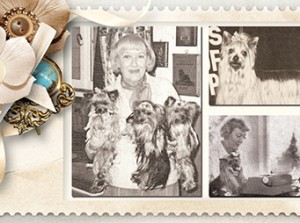Ann Seranne – A Recipe for Greatness
Click here to read the complete article
194 – September 2019
Every once in awhile, thanks to fate or faultless timing, a book arrives at an almost prescient moment, when everyone seems to be seeking expert guidance to light the way forward. Ann Seranne’s classic, The Joy of Breeding Your Own Show Dog, was one of those books. The title certainly sets the timeline, but, at least in this quadrant of the universe, sex wasn’t the only big discovery going on at that moment. The sport was riding an unprecedented and seemingly endless crest of popularity. Those spiking numbers represented legions of fanatical novices entering the game. They provided energy and enthusiasm that would power the sport to previously unimaginable heights. Annual registrations topping a million; shows topping 5,000 entries. New, wildly successful kennels sprouted like weeds in the ‘60s, ‘70s, and ‘80s. Many spawned bloodlines that endure to this day.
Plenty of superstars would emerge from those frantic decades. But, they had one thing in common. You see, in contrast to previous generations of fanciers, for the first time in purebred history they didn’t possess that essential DNA imprint of any prior legacy in the sport. They were starting from scratch, plotting their own course without any benefit of family tradition or actual mentors. So, where do you access core knowledge like evaluating a newborn pup’s vital signs or the mechanics of tube feeding if it’s in trouble? More importantly, how do you stay on course when every dang thing is going wrong? AKC had never confronted anything on this scale. Consequently, no one was worrying about the impending information gap.

Back in 1982, Howell Book House was churning out dog books like an assembly line. Like every other part of this growth cycle, there was an insatiable demand for published information on every breed. Many of those titles are considered classic references today. But even within that mix, Joy stood out as something exceptional. Her work didn’t offer the typical canned text recap of health information. This was the granular, detailed stuff, formerly learned directly from a breed mentor. It was groundbreaking. Actually, it’s hard to conceive of a book like this today. For one thing, that kind of blunt, hands-on, personal advice would never make it past legal.
It spoke with a sense of authority and genuine experience that comes only via unfiltered, brutal learning. Equally important was the pervasive sense of awe running through the whole thing. The title said it all. Ann Seranne was among those rare individuals possessing the ability to know their passion and the conviction to follow it. Baking a cake or orchestrating a tricky mating, Ann was very, very good at translating her enthusiasm into words.
For those unfamiliar with it, let’s fill in some back story, which is almost as interesting and inspiring as the book. Ann was what you’d call a dedicated hobby breeder. Like the rest of us, she grew up loving animals. She entered college as a Pre-Med major and graduated as a food chemist. She arrived in New York in 1936 with little more than expectations. But, when you know what you want, getting there is easy. Ever heard of Gourmet magazine? It was the industry standard for decades. A few years after getting her foot in the door as a receptionist, Ann was executive editor.
 Famous for her fabulous homemade pies, long before she embarked on her path to glory, Ann’s innate talent led to a multi-faceted career in the lucrative cookbook industry. She would eventually publish over 20 cookbooks. Delectable Desserts, published in 1962, and The Complete Book of Desserts, which came out a year later, remained top sellers for years. Later, she founded her own food consulting agency, Seranne and Gaden, with another former Gourmet editor.
Famous for her fabulous homemade pies, long before she embarked on her path to glory, Ann’s innate talent led to a multi-faceted career in the lucrative cookbook industry. She would eventually publish over 20 cookbooks. Delectable Desserts, published in 1962, and The Complete Book of Desserts, which came out a year later, remained top sellers for years. Later, she founded her own food consulting agency, Seranne and Gaden, with another former Gourmet editor.
In 1964, Ann’s newest project netted the largest cookbook advance in publishing history, but even then she had her sights set on bigger plans. As she explained in the intro to Joy, “Circumstances made me mark time with my breeding dream. I finished a few homebred champions, but living and working as I did, in the heart of New York City, I had neither time, space, nor money to breed and show on an extensive scale. It was not until I met Barbara Wolferman, also a New Yorker, who had owned and loved Yorkies for 25 years, that my dreams became a reality. We met at a cocktail party, and it didn’t take us long to find out that we had much in common.” Along with Broadway shows and fine food, they shared “a passionate devotion to the Yorkshire Terrier breed.”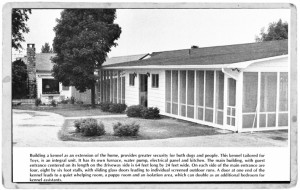
A lifetime New Yorker, Barbara Wolferman had carved out a high powered career as a casting director (Not all of us are conversant with superstars of the food biz, but if you haven’t heard of Rodgers and Hammerstein, I give up.). Barbara had owned Yorkies since 1953. Although she hadn’t yet ventured into the show scene, she understood quality. Her first pup came from Arthur Mills’ famed Millbury Kennel. By the time they met, she was a diehard convert, however, as Ann explained, “At that point, Barbara could not imagine taking one of her beloved Yorkies to a dog show.” This was possibly the most coddled breed of the entire Toy group. In Britain, they weren’t even required to walk around the ring. But, Ann convinced Barbara to give it a go.
We are all familiar with the thoroughly horrifying ambiance of some indoor show sites. Bronx Kennel Club, then held at the Armory, quite possibly topped that list. It surpassed every expectation for cold, damp, and bleak, and, better yet, Ann’s dog never made it out of the Breed. She said, “It was perhaps the worst choice I could have made.” We can safely call that a true test, and Barbara Wolferman “…loved every bone chilling moment of it. She took to dog shows like the proverbial duck, and immediately wanted to buy a show dog. It was not long before [they] joined forces and moved to an eleven acre hilltop ranch in northern New Jersey. “
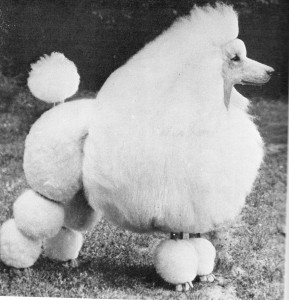 Ann wrote, “We both had reached an age when we had the education, intelligence, financial security, and ambition to attempt to develop a strain of Yorkshire Terriers within our interpretation of the breed standard that would someday breed true.” Ann’s description of their partnership revealed her genuine dog breeder mentality, “Although differing in temperament, personality, and capabilities, we were remarkably complimentary to each other, and by pooling our resources, our combined talents, and varied interests in breeding and showing, we were able to launch a full scale breeding and showing program.”
Ann wrote, “We both had reached an age when we had the education, intelligence, financial security, and ambition to attempt to develop a strain of Yorkshire Terriers within our interpretation of the breed standard that would someday breed true.” Ann’s description of their partnership revealed her genuine dog breeder mentality, “Although differing in temperament, personality, and capabilities, we were remarkably complimentary to each other, and by pooling our resources, our combined talents, and varied interests in breeding and showing, we were able to launch a full scale breeding and showing program.”
Anyway, the main point is that when they made this fateful decision, both were dug in at the pinnacle of incredibly competitive, lucrative fields. They had defied all odds getting there. The fact that they were women made it more impressive. This was the era of the modern woman. For the first time in recorded history, women weren’t blocked from that level of success. More importantly, career goals weren’t chained to any social expectation to eventually marry and raise families. The idea of walking away from that hard won life in order to breed dogs full time was, well, basically beyond comprehension to most of their contemporaries. But as anyone reading this knows, when this incredible purebred universe invites you in, ‘no’ is simply not an option.
In 1966, Ann and Barbara purchased a big chunk of real estate in northern New Jersey horse country and established Mayfair Barban kennel. In December, 1967, their startup venture was chronicled for Popular Dogs by the writer/editor Joan Brearley. “These two dedicated dog lovers have left their New York City careers behind and, for the past year, have been devoting all their energies to making their dream come true.” They had each owned Manhattan brownstones and were accustomed to lots of space. The house was enormous and designed to display their combined troves of art and antiques, and, needless to say, it featured a state of the art, professional dream kitchen. There was also a fabulous walnut paneled trophy room. The hand sewn curtains were the centerpiece, made entirely from winning show ribbons, which got longer by the year.
Then, there was the kennel. Wendell Sammet needs no introduction. Back then, he was synonymous with Mayfair Barban’s unstoppable winners. “They did the whole place to ensure the dogs were happy and healthy. You couldn’t call it a box kennel. The dogs were never crated. They lived in open pens with huge exercise areas, and, of course, it was right off of the house, so there was lots of activity. People were always going in and out. The dogs loved it.”
The kennel, the primary intention of this build, was adjacent to the house. Brearley took her readers through a tour. In addition to the spacious grooming room, it had an in-house vet clinic “complete with a hospital operating room. These facilities [were] personally outfitted by their veterinarian for any and all emergencies, and/or routine veterinary visits so that the dogs (especially the puppies) need not be taken out of the house.” One massive wing, which would eventually include a 60-foot glass-walled interview room for prospective puppy buyers, was still under construction when Brearley visited. But, she saw more than enough to envision the full, spectacular scope of Mayfair Barban. This place wasn’t interesting simply because it was fabulous, that was just a side note. It was hot news, mainly because nobody in the dog biz did that sort of thing anymore.
Brearly’s feature for Popular Dogs was in the spirit of those gorgeous spreads that ran in the AKC Gazette back in the 1930s, showcasing grand kennels that had pretty much ceased to exist by 1967. In that sense, this place was an anachronism. The sport was no longer dominated by independent, wealthy autocrats with the resources to maintain gigantic show kennels. The demographics of the sport had shifted decidedly towards middle class hobby breeders, raising the occasional litter under the kitchen table. In contrast to Mayfair Barban with the celebrated Wendell Sammet onboard, in addition to Peter D’Auria as fulltime, live-in kennel manager, most fanciers were flying solo and learning on the job.
So, getting back to The Joy of Breeding Your Own Show Dog, this new wave of fanciers came from every sector of society. That didn’t really matter because they were all in the same boat regarding the part of this deal that never changes. Success demands a mind boggling amount of technical knowledge. Unfortunately, that post-WWII demographic rearrangement did more than invite millions of energetic novices into the game. It also formulated the demise of the intergenerational expertise that went with those grand kennels and, thanks to the rapid implosion of bench shows, the primary second hand source of that knowledge. These were not the only significant factors, but, overall, they drastically curtailed the pervasive learning opportunities that were formerly built into the sport.
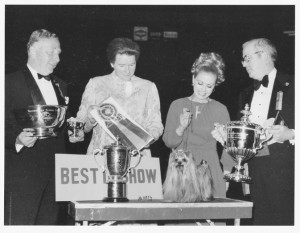 Of course, Ann and Barbara weren’t contemplating any of this when they embarked on this dream. They had enough going on already. Maybe it was just luck, but their timing was impeccable. This was the age of great hair products and glorious presentation that totally reset the dial for drop-coated breeds. That wasn’t the only reason, but after centuries off the grid, Yorkshire Terriers were finally hitting it big. AKC’s 1967 year end stats (Remember when they used to share those details) put the breed in 23rd place with 7500+ registrations that year, up from 25th the previous year. Ten years later, those numbers looked like a joke. AKC had surpassed that mythical million dog mark, and the whole sport was sailing in the comfort zone by 1978, when the Gazette’s annual roundup lamented a three percent drop in annual registrations, calling it a nosedive. “The year long decline, which was accelerating as 1977 drew to a close, indicates that for the first time in the 1970s total registrations will dip below the one million mark.”
Of course, Ann and Barbara weren’t contemplating any of this when they embarked on this dream. They had enough going on already. Maybe it was just luck, but their timing was impeccable. This was the age of great hair products and glorious presentation that totally reset the dial for drop-coated breeds. That wasn’t the only reason, but after centuries off the grid, Yorkshire Terriers were finally hitting it big. AKC’s 1967 year end stats (Remember when they used to share those details) put the breed in 23rd place with 7500+ registrations that year, up from 25th the previous year. Ten years later, those numbers looked like a joke. AKC had surpassed that mythical million dog mark, and the whole sport was sailing in the comfort zone by 1978, when the Gazette’s annual roundup lamented a three percent drop in annual registrations, calling it a nosedive. “The year long decline, which was accelerating as 1977 drew to a close, indicates that for the first time in the 1970s total registrations will dip below the one million mark.”
The article featured an analysis of breed trends. The phenomenon they dubbed the Saint Bernard Syndrome was coming to mainstream attention. The Gazette conceded, “Whim, aesthetic appeal, and impulse all figure into decision making processes of dog buyers…individual breeds are going to be victims of fads.” Clearly, trouble was brewing in that regard. So-called puppy mills had been a regular topic at delegates meeting for a decade. All of that would spin out on a familiar tangent that’s not pertinent to this story. What is pertinent is the fact more than a few of those hopeful, naïve, first-time buyers represented a deluge of new competitors entering the wonderful world of purebred dogs.
Although no Toy breeds then ranked in the top ten, Yorkie registrations already heralded that trend. Individual registrations for the year, over 22,000, moved them to 14th place, up from 16th the previous year. And 1977 litter registrations put Yorkies eighth overall. The breed had become a competitive force in the game.
Wildweir, along with Trivar and Windamere, were just some of the American kennels that imported decisive dogs from Britain in those years. For instance, Ch. Progress of Progresso, imported by Windamere in 1962, had been the top winning Yorkie in England. His impact on American bloodlines was pervasive. These breeders didn’t simply import winners, they imported genetic building blocks.
Ann’s serious involvement with the breed dated to 1960, when she finished Ch. Renrel We Puddin’ of Yorkshire, bred by David and Nancy Lerner. Two years later, she purchased Am./Can. Ch. Topsey of Tolestar from the Lerners. Topsey had done nice winning while owned by Renrel and would become a top producer for Mayfair. Her first litter yielded her first homebred winner, Ch. Dandy Diamond of Mayfair, whelped in 1964. He retired with 14 group placements, ranking as a top ten Yorkie for 1966. His littermate, Ch. Dondy Duke of Mayfair, would also sire two champions. One year after setting up shop, Ch. Danby’s Belziehill Amanda became their first group winner. A Dandy Diamond son, Am./Can. Ch. Mayfair’s Oddfella was their next success, retiring with 76 Breed wins, 35 group placements, and 12 Firsts, including BIS at Progressive. This evolving bloodline netted steady results, which, obviously, confirmed that a discerning eye was calling the shots.
“Teddy of Mayfair was the dog that really put them on the map,” recalls Sammet, “He was the first one with any leg under him and he had a decent topline,” a trait in short supply back then. The fine points of Yorkshire Terrier breeding might be likened to a Rubik’s Cube of purebred genetics. If you don’t keep the big picture in mind, you’re sunk. He says, “I run into the same thing in Poodles. The hair is an illusion of the dog. So many breeds can be ruined that way. Coat overtakes every aspect of type.” Sammet emphasizes that, despite his rockstar career as a handler, he is first and foremost a breeder. “There are so many challenges to master before you even get the dog into the ring. Yorkshire Terriers require so much. Conformation to begin with–to get proper structure, a straight topline, and a correct head, is incredibly difficult. Then put the proper color and correct silky coat on top of it. Years ago, color was very, very difficult. We didn’t dye them, you know, and Teddy’s color was okay. Yorkies have improved so much over the last 20 years. Now, you see many dogs with straight toplines and decent color. We know a lot of them are dyed, but you can always tell the difference. When you can see the gradations in the head coat, you know it’s not dyed,” he says. Remember that bit of wisdom.
Am./Can. Ch. Gaytonglen Teddy of Mayfair deserved a good share of credit for the breed’s rise. Purchased from Doris Craig in 1967, he won 4 BIS, 26 groups, 55 placements, 115 Breeds, and the 1970 and ‘73 New York specialties. He also sired 22 champions, including BIS winner Ch. Mayfair Barban Yam and Yelly. Ann and Barbara not only had an eye for type, they recognized talent. As Sammet recalls, “I loved hair and I was good with coat, but I wasn’t even in the breed when they approached me to handle dogs for them. I admired what they were doing and being associated with them was an education for me as well,” and, it goes without saying, “The dinners were always great.”
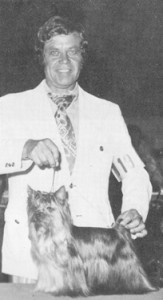
He recalls, Ann and Barbara were total opposites. Barbara was very sweet, she loved everyone and everyone loved her.” Sammet characterizes her as the public persona of Mayfair Barban. “She did most of the conditioning and handling. Barbara loved showing, but Ann was the breeder. She didn’t go to the shows most of the time; she didn’t really care for it.”
Unconventional, perhaps, but the arrangement definitely worked. Ch. Danby Belziehill Raindrop, Ch. Mayfair Barban X-Tract, Ch Mayfair Barban Kasha, Ch. Mayfair Barban Mocha Mousse (sire of seven champions, including X-Tract and Raindrop) and his dam, Ch, Mayfair Barban Upsa Daisey, BOS at 1969 and ‘70 YTCA NY specialties. Mayfair Barban wasn’t merely campaigning winners, this truly was “the joy of breeding your own show dog.”
With Wendell Sammet onboard, the acquisition of Poodles was inevitable. Topping that list was Ch. Alekai Pokoi. Whelped in 1961, she held the record in Standards with 16 BIS, until Frank Sabella came out with Lollipop. “They were doing very well in Yorkies, and they wanted something different,” Sammet says, “and they liked my Alekai dogs, so, I sold them a good dog to promote. Ann did a couple of breedings that were very good. Ann was so talented and a very good competitor, but very domineering. We had many fights and disagreements, but we accepted each other’s opinions.” He describes their relationship as one of mutual learning and respect. “She did a lot of inbreeding and tight linebreeding for seven or eight generations, and she constructed an amazingly consistent breeding program.”
?Ann dissected numerous important pedigrees for her book, including the infrastructure of Quinnat’s half-brother, Ch. Mayfair Barban Verikoko, a dog she considered to be the closest to their concept of ideal type. She recounted and analyzed the many backcrosses in his pedigree to illustrate the step-by-step distillation of desirable traits through intensive, thoughtful linebreeding.
?And then there was Teddy’s grandson, Ch. Mayfair Barban Loup-de-Mer. They were justifiably proud of him, as Ann stated in her book, “Ch. Mayfair Barban Loup de Mer was the first Mayfair Barban Yorkshire Terrier born with that special quality that set him apart and made him a natural in the show ring. He was the first breakthrough in bringing to the surface correct body coat color genes.” Linebreeding, inbreeding, and refining that tricky genetic package is a painstaking process. There’s never a guaranteed payoff, but Loupy was top Yorkie in 1974-75 and ranked number five Toy in 1976.
By then, Mayfair Barban had 45 champions to its credit. They were setting records, breaking records, and enlarging the trophy room repeatedly. But, as Sammet admits, it didn’t come easy, “There are so many disappointments in breeding Yorkshire Terriers. Basically, all Toys present exceptional challenges. But this one is never easy. I admire anyone who takes it on.”
Money, management, and expertise definitely smoothes that road to success, but one incontrovertible fact of the game is that no amount of it prevents some disasters. As many of us know, every litter arrives with a surprise package of potential complications. Surpassing all the usual issues was the unforeseen outbreak of a brand new, highly contagious, fatal disease. Parvovirus hit the 1970s dog world with a devastating ferocity that had become a distant memory since the advent of effective vaccinations in the 1950s. The first edition of Joy included this rather chilling quote, “Parvoviral enteritis seems to be something new and horrendous. No vaccines have yet been developed to counteract it.” Ann spoke from experience. By then, Loupy had sired three litters. As an important stud, he was just getting started. Those six pups included four champions. As she recounted, “Then the hand of fate struck the authors’ breeding program a crippling blow. The little dog contracted viral enteritis at a show. He survived, but the ordeal rendered him sterile.” Even so, those three litters seeded the future of the Mayfair Barban bloodline.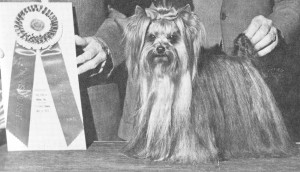
There’s a simple reason for the phenomenal success of Ann’s cookbooks. She knew how to drill down past the hot air and provide plain spoken, practical, nuts and bolts information. As she explained in the intro to Good Food and How to Cook It, she wasn’t out to impress her readers with complicated exotica. Her goal was “to make clear fundamentals and techniques which – once you have seen how they repeatedly work the same way despite surface variations- make the difference between a stumbling and a knowledgeable cook.” Getting it right required some basic skill and effort, but it was definitely within reach of anyone dedicated to doing that work.
A decade later she repurposed that straightforward concept into The Joy of Breeding Your Own Show Dog. She took her readers step by step through the basics and the complexities, everything from evaluating structural soundness to analyzing pedigree data and calculating semen quality. The book was packed with diagrams, charts, formulas, and close-up, step-by-step photos, explaining every step of every topic. She covered every possible pitfall and complication of stud dog management, whelping litters, neonatal development; all the frightening, interconnected subjects required to successfully plan and produce a top quality litter. And it was all built on the same direct, organized, totally honest gridwork that made her cookbooks bestsellers. It demands some effort, but it’s not rocket science.
Julie Gasow’s foreword called it, “The best book of its kind I have ever read, fascinating reading and an invaluable aid for all breeders. It is thorough and orderly presentation, delightfully written with knowledge and sincerity.” And it’s safe to say that Julie Gasow knew a couple things about breeding dogs.
Ann died August 16, 1988. By any standard, hers was an unconventional life. Satisfying and fulfilling, there was no question about that; as every good breeding program hopes to do, Mayfair Barban contributed to the breed’s improvement, but Ann overshot that goal by a mile. It’s simplistic to compare breeding a winner to baking a pie. But then again, maybe it jives. Both objectives demand patience, technical ability, intrinsic know-how, and artistic sensibility. Some of that comes by the book, but marrying that polyglot skillset into one masterpiece is another story. It comes with many failures and no promises. She didn’t sugarcoat the realities. She laid it all out there–good, bad, and ugly–basically the same blueprint of her cookbooks. There’s no hope for me in the kitchen, but The Joy of Breeding Your Own Show Dog definitely got me hooked on this sport. It managed to define and explain the secret recipe to conjure up an impossible reality, but, most of all, it presented readers with the unparalleled delight of getting it right. She left a great legacy to her breed, but a far bigger one to the sport. You don’t do it better than that.
Click here to read the complete article
194 – September 2019

Short URL: http://caninechronicle.com/?p=170044
Comments are closed











